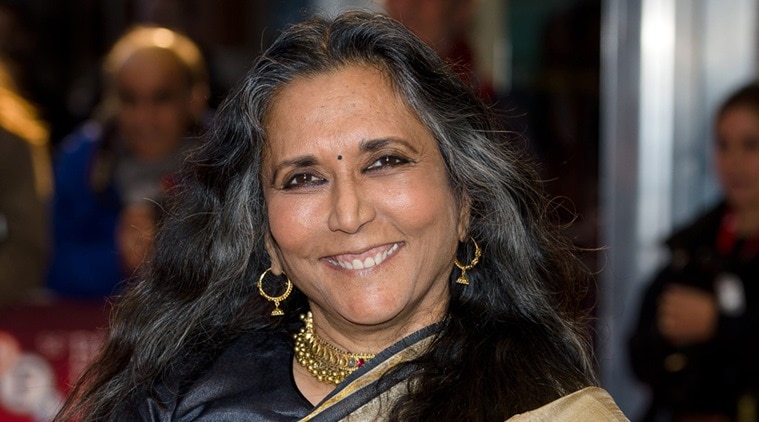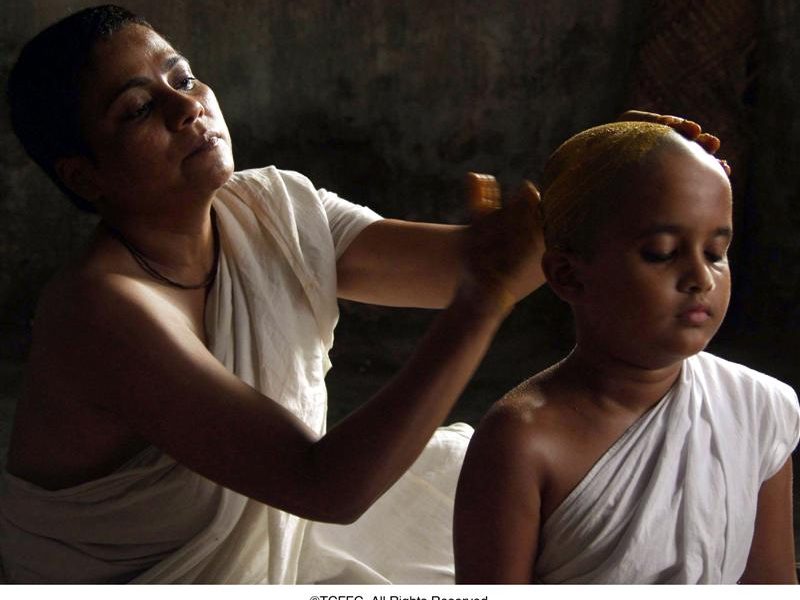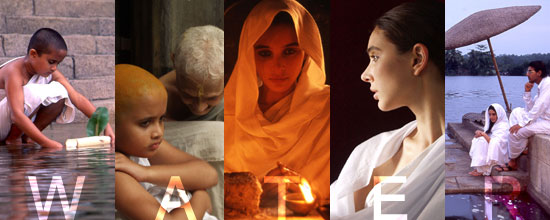A widow should be long suffering until death, self-restrained and chaste. A virtuous wife who remains chaste when her husband has died goes to heaven. A woman who is unfaithful to her husband is reborn in the womb of a jackal.
-The Laws of Manu, Chapter 5, Verse 156-161, Dharmashastras
Deepa Mehta’s Water (2005) is set in Banaras (Varanasi), in the pre-independent India of 1938. Water is the third film of the elements trilogy by Deepa Mehta, whose Earth (1998) dealt with Partition of India and Pakistan, and whose Fire (1996) centred around two married women, ignored and neglected by their husbands, who fall in love with each other. The sets for Water were destroyed by religious fanatics and the entire production of the movie had to be shifted to Sri Lanka.
The Manusmriti, an ancient Hindu text, says that in life a woman is half her husband and if he dies, she is half-dead. A widow has three choices – she can throw herself on his funeral pyre and die with him, she can marry his brother, if family permits, or she can live out the rest of her days in isolation and devotion. If she chooses the last option, the ascetic path, she enters an ashram, shaves her head, ‘sacrifices’ her desires, wears white as a sign of mourning, and tries to atone for her husband’s death.

Deepa Mehta. Image Source: Indian Express
In an interview, Deepa Mehta stated, “Water can flow or water can be stagnant. I set the film in the 1930s but the people in the film live their lives as it was prescribed by a religious text more than 2,000 years old. Even today, people follow these texts, which is one reason why there continues to be millions of widows. To me, that is a kind of stagnant water. I think traditions shouldn’t be that rigid. They should flow like the replenishing kind of water.”
In the film, Chuhyia (Sarala), an adorable eight-year-old, has just been widowed. She doesn’t even remember her wedding. The little girl’s head is shaved, and she is dressed in a white robe. Her father takes her to a decrepit ashram where widows of all ages live together. She sleeps on a thin mat in a room with older and infirm women whose lonely lives have been spent in renunciation. They sing religious hymns every day and beg on the streets for money. People avoid them like the plague as it was a commonly held belief that if someone should bump into a widow, they will be polluted and must do rituals of purification.
Narayan provides the best explanation for this practice – “One less mouth to feed, four less saris, and a free corner in the house. Disguised as religion, it’s just about money.”
Water beautifully depicts the heterogeneity of widowhood. Chuhiya is a child widow who hopes to return to her home. She hopes that one day her mother will come to take her back. Madhumati (Manorama), the domineering woman in charge, tells Chuhiya not to feel pain as she is half-dead because her husband had died. Ironically, she could be seen crying over the death of her beloved pet parrot signifying the futility of such hollow religious ideals.

Shakuntala. Image Source: Zeke Film
Shakuntala (Seema Biswas) is a respected Brahmin woman in the Ashram. She’s a devoted woman but her ‘devotion’ failed to provide her ‘salvation’. Shakuntala has a pivotal role in the whole movie. She questions the foundations of the theory of widowhood. It is Narayan, a follower of Gandhi, who provides the best explanation for the ancient practice: “One less mouth to feed, four less saris, and a free corner in the house. Disguised as religion, it’s just about money.”
Also read: My Lipstick Waale Thoughts on ‘Lipstick Under My Burkha’
Shakuntala emerges from being a devotee and a woman of faith to a woman who starts questioning the blind traditions and emancipates Chuhiya. Bua is an old widow who keeps reminiscing about her wedding day – not for her parents or her husband but for the lavish meal, especially the laddoos she had that day for the last time. She tells Chuhiya, “Life is so disappointing.” Bua dies the very day she eats a laddoo given to her by Chuhiya. Saddened by Bua’s death and also frightened as Bua committed a sin by eating laddoo, she tells everything to Shakuntala, to which Shakuntala replies, “Don’t worry. Bua will go to heaven after eating the laddoo. And if God wills, she will born as a man in her next life.“
Chuhiya meets Kalyani (Lisa Ray), who unlike other widows has long hair for a disturbing reason. Chuhiya and Kalyani become great friends. Kalyani is a young beautiful widow with hope in her heart. She meets Narayan (John Abraham), who is a fresh law graduate and an ardent Gandhian. The movie revolves around their unusual love story with a tragic end.
Water is a movie that throws light on intersectionality at many instances. Gulaabi is a transgender pimp played extraordinarily by Raghubir Yadav. A transgender person working as a pimp depicts the harsh reality of a trans person’s life. It also compels us to ask ourselves how little transgender people’s lives have changed in the last century with sex work and begging has remained being their staple employment.
Casteism is also showcased in the entire movie. Even among widows, Brahmin widows were given prominence and respect. It was believed that Brahmin men can sleep with whomever they want and the women they sleep with are blessed.
Though the movie revolves around their love story, the soul of the movie remains Shakuntala’s awakening, her inner struggle between faith and conscience.
It is pertinent to mention that Water has some strong men who play crucial role in the movie. Narayan who questions the status quo, Guru (Kulbhushan Kharbanda) who informs Shakuntala about the law on widow remarriage that nudged her to support Kalyani to remarry, and of course, Gandhi.
In the words of Deepa Mehta, “Water is about the importance of tolerance. John (Abraham) keeps joking saying that he thought he was the hero of the film but actually, he felt Gandhi was the hero of the film. Which is true…It’s not about being anti-Hindu; it’s about being pro-life.” Through Narayan, we saw how Gandhi reformed a great number of people with his truth and idealism. It also ends with the hope that Gandhism gave in that era.
Water explores how religion is used as a tool to manipulate and exploit an entire class of women and the way patriarchal imperatives inform religious belief. And how in a patriarchal setup, scriptures are interpreted in favour of men and the privileged strata of society.
Also read: ‘Naseem’ Film Review: An Age That Had Passed
Water beautifully captures female relationships. It teaches how traditions and rituals should be questioned from time to time. Though the movie revolves around the love story of Kalyani and Narayan, the soul of the movie remains Shakuntala’s awakening, her inner struggle between faith and conscience. The movie ends with Shakuntala’s act of bravery instilling hope and optimism in the viewers.
Featured Image Source: Dialogic Cinephilia




